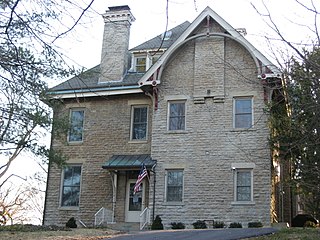
Twin Oaks, also known as the "Robert Reily House", is a historically significant residence in the city of Wyoming, located near Cincinnati in the southwestern corner of the U.S. state of Ohio. Constructed in the middle of the nineteenth century, it was the home of Robert Reily, one of the leading citizens of early Wyoming. Its heavy stone architecture features a mix of two important architectural styles of the period, and it has been named a historic site.

The Elias Kumler House is a historic residence in Oxford, Ohio, United States. Constructed in the 1850s, it was originally the home of Elias Kumler, who held large influence at multiple educational institutions in Oxford. The house has been continuously used for residential purposes, and it has been named a historic site.

The James D. Conrey House is a historic house located on an old intercity road in southeastern Butler County, Ohio, United States. Although the identification is unclear, it may have once been a tavern on the road, which connects Cincinnati and Columbus. A well-preserved piece of the road's built environment, it has been designated a historic site.

The Symmes Mission Chapel was a historic church building in the city of Fairfield, Ohio, United States. A simple structure constructed in the 1840s, it was named a historic site in the 1980s, but it is no longer standing.

The Cray House is a two-room house in Stevensville, Maryland. Built around 1809, it is a rare surviving example of post-and-plank construction, and of a build of small house which once dominated the local landscape. For these reasons it was listed on the National Register of Historic Places in 1983.

The Gregory House is a historic hotel in central New London, Ohio, United States. Erected soon after a fire that devastated the community, it has occupied a significant place in the community since its construction, and it has been named a historic site.

The Octagon is a historic octagon house on the campus of Heidelberg University in Tiffin, Ohio, United States. Built in the mid-19th century, it has been used for residential purposes throughout its history, and while it has experienced over a century of gradual deterioration, it has been named a historic site, and the 21st century has seen plans to restore it to its original integrity.

The Rochester Downtown Historic District is a historic district on the National Register of Historic Places (NRHP) in Rochester, Indiana, United States. It was placed on the Register on June 24, 2008. The majority of buildings in the area are masonry and Italianate while structures outside the district are largely residential frame built structures.

The Cuyahoga County Courthouse stretches along Lakeside Avenue at the north end of the Cleveland Mall in downtown Cleveland, Ohio. The building was listed on the National Register along with the mall district in 1975. Other notable buildings of the Group Plan are the Howard M. Metzenbaum U.S. Courthouse designed by Arnold Brunner, the Cleveland Public Library, the Board of Education Building, Cleveland City Hall, and Public Auditorium.

The Coshocton County Courthouse, designed in Second Empire style, is a historic courthouse building located at 349 Main Street in Coshocton, Ohio. It was added to the National Register of Historic Places on 1973-05-22.

The U.S. Post Office in Medina, New York, is located at West Avenue and West Center Street. It is a brick building erected in the early 1930s, serving the ZIP Code 14103, covering the village of Medina and neighboring portions of the towns of Ridgeway and Shelby.

Holy Rosary Catholic Church is a historic Catholic parish church in the Little Italy neighborhood of Cleveland, Ohio, United States. Founded in the early 1890s, the parish completed the present Baroque-styled church shortly before 1910; the building has been named a historic site.

The Union Block is a historic business building on Public Square in downtown Lima, Ohio, United States. Built in 1878, it is a three-story brick building with a modified rectangular floor plan and a sloping roofline.

The Clinton Downtown Historic District is a historic district located in the village of Clinton in Clinton Township in the northernmost portion of Lenawee County, Michigan. It consists of most of the 100 block of U.S. Route 12, known locally as West Michigan Avenue, plus Memorial Park at 200 West Michigan. The district was added to the National Register of Historic Places on April 27, 2010.

The Nativity of the Blessed Virgin Mary Catholic Church is a historic Catholic church in Cassella, an unincorporated community in Mercer County, Ohio, United States. One of several Catholic churches in Marion Township, it has been designated a historic site because of its well-preserved nineteenth-century architecture.

The Stratford Methodist Episcopal Church is a historic former church building located near the city of Delaware, Ohio, United States. Constructed in the 1840s for workers in a company town, it was home to a congregation of the Methodist Episcopal Church until the community faltered following the company's closure. Situated at the southern end of the company town, it remains prominent because of its architecture, and it has been named a historic site.

The First Unitarian Church of Marietta is a historic Unitarian Universalist church in the city of Marietta, Ohio, United States. Founded in 1869, it uses a building constructed in 1858 for one of its two predecessor churches; this building's high-quality architecture has led to its designation as a historic site.

Lawler's Tavern is a historic commercial building in the village of Mechanicsburg, Ohio, United States. Built in 1830, it is one of the oldest buildings in the community, and it has been named a historic site.

Hotel Love, at 200 W. Main St. in Purcell, Oklahoma, was built in 1896. It was restored by Jerry and Elaine Butler in 1993 and recognized on the National Register of Historic Places in 1995.






















